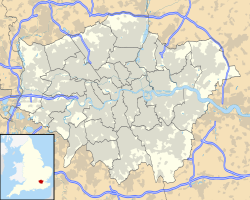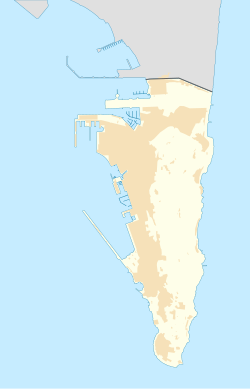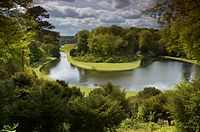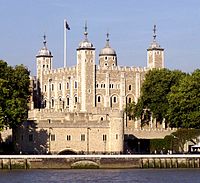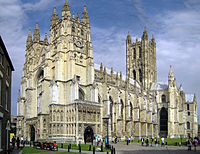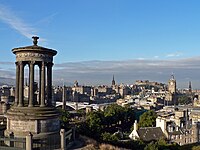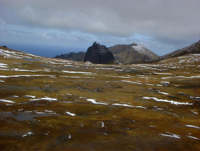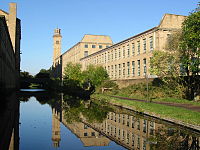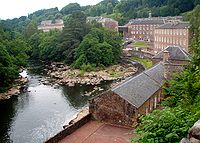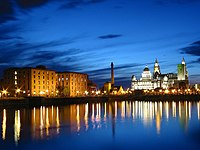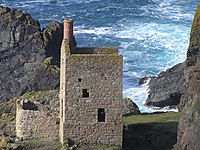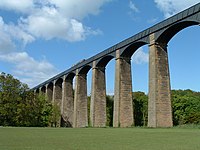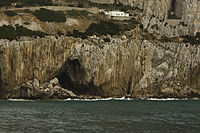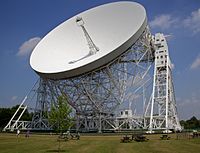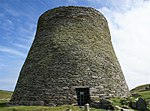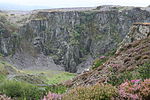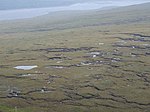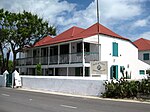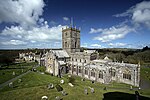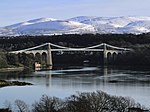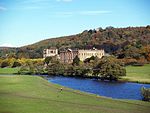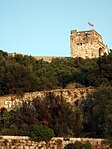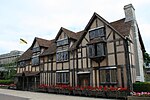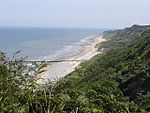World Heritage in the UK
For World Heritage in the UK include (as of 2019) 32 UNESCO World Heritage sites , including 27 sites of world cultural heritage, four sites of the world natural heritage and a mixed cultural and natural heritage site. The United Kingdom ratified the World Heritage Convention in 1984 and the first six World Heritage Sites were added to the World Heritage List in 1986. The last World Heritage Site to date was registered in 2019, and one site is on the Red List of World Heritage in Danger .
cards
With 18 sites, most of the World Heritage Sites are in England , four of which are in the Greater London administrative area alone . There are five sites in Scotland and three in Wales . There is also a World Heritage Site in Northern Ireland , on the Bermuda Islands , on the Pitcairn Islands , on the Tristan da Cunha archipelago and in Gibraltar .
|
|
|
||||||||
|
|
|
World heritage sites
The following table lists the UNESCO World Heritage Sites in the United Kingdom in chronological order by year of their inclusion on the World Heritage List (K - Cultural Heritage, N - Natural Heritage, K / N - Mixed, (R) - on the Red List of World Heritage in Danger ).
![]() Map with all coordinates of World Heritage Sites: OSM
Map with all coordinates of World Heritage Sites: OSM
| image | designation | year | Type | Ref. | description |
|---|---|---|---|---|---|
|
The "Giant's Causeway" and its coast ( location ) |
1986 | N | 369 | According to an Irish legend, the Giant's Causeway (English for the giant's dam ) was built by a giant. It consists of 40,000 basalt columns protruding from the sea and was created through volcanic activity in the Tertiary. | |
|
Durham Castle and Cathedral ( location ) |
1986 | K | 370 | Durham Cathedral is the "greatest and most beautiful" example of Norman architecture in England and the cathedral's vault was part of the rise of Gothic architecture. The cathedral houses relics of St. Cuthbert and Bede. Durham Castle , Norman, was the residence of the Prince-Bishops of Durham. | |
|
Ironbridge Gorge ( location ) |
1986 | K | 371 | Ironbridge contains mines, factories, workers' housing, and the transportation infrastructure that was created in the gorge during the Industrial Revolution. The development of the production of coke in the region helped in the Industrial Revolution. The bridge over the Severn was the world's first iron bridge and was architecturally and technologically influential. | |
| Studley Royal Park with the ruins of Fountains Abbey | 1986 | K | 372 | Prior to the dissolution of the monasteries in the mid-16th century, Fountains Abbey was one of the largest and richest Cistercian monasteries in Great Britain and is one of the few to come and survive the 12th century. The later garden, which includes the abbey, survives to a large extent in its original design and influenced garden design in Europe. | |
| Stonehenge, Avebury and related monuments of megalithic culture | 1986 | K | 373 | The Neolithic sites of Avebury and Stonehenge are two of the largest and most famous megalithic monuments in the world. They relate to human interaction with their environment. The purpose of the henges is a source of speculation, with suggestions from ceremonies around the interpretation of the cosmos. Associated places of worship include Silbury Hill , Beckhampton Avenue and West Kennet Avenue .
expanded in 2008 |
|
| King Edward's castles and city walls at Gwynedd | 1986 | K | 374 | During the reign of Edward I of England (1272-1307), a number of castles were built in Wales with the aim of subjugating the population and establishing English colonies in Wales. The world heritage site includes many castles including Beaumaris Castle , Caernarfon Castle , Conwy Castle and Harlech Castle . The castles of King Edward I are considered the pinnacle of military architecture. | |
| St. Kilda archipelago | 1987 | K / N | 387 | The islands' human heritage include various unique architectural features from both historical and prehistoric times. It was inhabited for over 2,000 years. Many important seabird species live here, including the world's largest colony of gannets and up to 136,000 pairs of puffins.
expanded in 2005 and 2008 |
|
| Blenheim Castle | 1987 | K | 425 | Blenheim Palace, the residence of John Churchill, 1st Duke of Marlborough, was designed by architects John Vanbrugh and Nicholas Hawksmoor. The associated park was created by Capability Brown. The palace celebrated the victory over the French and is of importance for the construction of English romantic architecture as a separate unit from French classical architecture. | |
| Westminster (palace and abbey) and Church of St. Margaret | 1987 | K | 426 | The world heritage site has been involved in the administration of England since the 11th century and later in the United Kingdom. Since the coronation of William the Conqueror, all English and British monarchs have been crowned at Westminster Abbey . The Palace of Westminster , home of the British Parliament, is an example of Gothic Revival. St Margaret's Church is the parish church of Parliament. | |
| City of Bath | 1987 | K | 428 | Founded by the Romans as a spa town, an important center of the wool industry in medieval times, and a spa town in the 18th century, Bath has an eventful history. The city is known for its preserved Roman ruins and Palladian architecture | |
| Borders of the Roman Empire | 1987 | K | 430 | The Limes was created in the Roman Empire to defend the borders of the Roman Empire .
Hadrian's Wall , built in 122 AD , was added to the World Heritage List in 1987. After the World Heritage site was expanded in 2005 to include the Upper Germanic-Raetian Limes in Germany, the Antoninus Wall in Scotland, built in 142 AD, was added in 2008 . |
|
| Henderson Island South Sea | 1988 | N | 487 | Henderson Island is an atoll in the Pitcairn Islands in the south of the Pacific Ocean. The ecology, which is almost untouched by humans, and its isolation shows the dynamics of evolution. There are ten plant and four native animal species on the island. | |
| Tower of London | 1988 | K | 488 | Starting from William the Conqueror in 1066 during the Norman conquest of England, the Tower of London is a symbol of power and an example of Norman military architecture spread across England. The extensions under Henry III. and Edward I in the 13th century made the castle one of the most influential buildings of its kind in England. | |
| Cathedral, former St. Augustine's Abbey and St. Martins Church in Canterbury | 1988 | K | 496 | The St. Martin's Churchist the oldest church in England. The Church and Abbey of St. Augustine were founded in the early stages of the introduction of Christianity to the Anglo-Saxons. The Canterbury Cathedral has Romanesque and Gothic architecture and is the seat of the Church of England. | |
| Edinburgh | 1995 | K | 728 | Edinburgh Old Town was founded in the Middle Ages, and the New Town was developed in 1767–1890. It contrasts the face of the settlements in medieval and modern times. The shape and architecture of the new city, designed by luminaries such as William Chambers and William Playfair, influenced European urban planning in the 18th and 19th centuries. | |
| Gough and Inaccessible Islands | 1995 | N | 740 | Together, the islands of Gough and Inaccessible in the Tristan da Cunha archipelago in the South Atlantic preserve an ecosystem that is almost untouched by mankind, with many native species of plants and animals.
In 1995 the island of Gough was first added to the world heritage, in 2004 Inaccessible was added. |
|
| Maritime Greenwich | 1997 | K | 795 | In addition to the first example of Palladian architecture in England, as well as works by Christopher Wren and Inigo Jones, the Greenwich area is significant for the Royal Observatory, where the understanding of astronomy and navigation was developed. | |
| Neolithic monuments in the Orkney Islands | 1999 | K | 514 | A collection of Neolithic settlements with purposes ranging from settlement to worship. It includes the settlement of Skara Brae, the burial chamber of Maes Howe, and the stone circles of Stenness and Brodgar. | |
|
Historic city of St. George with fortifications ( location ) |
2000 | K | 983 | Founded in 1612, St. George is the oldest English city in the New World and an example of the planned urban settlements in the New World established by colonial powers in the 17th century. The fortifications show defensive techniques developed through the 17th to 20th centuries. | |
| Blaenavon industrial landscape | 2000 | K | 984 | ||
|
Saltaire industrial village ( location ) |
2001 | K | 1028 | Saltaire was founded by the mill owner Titus Salt as a model village for his workers. The World Heritage Site, which includes the Salts Mill, featured public buildings for residents and was an example of patronage from the 19th century. | |
| Dorset and East Devon coast | 2001 | N | 1029 | The rocks consisting of the Dorset and Devonian coasts are an important fossil site and provide a continuous record of land and sea life in the area for 185 million years. | |
|
Derwent Valley industrial landscape ( location ) |
2001 | K | 1030 | Derwent Valley Mills was the birthplace of the factory system; the innovations in the valley, including the development of workers' settlements - like at Cromford - and machines like the Water Frame, were important in the Industrial Revolution. The Derwent Valley Mills influenced North America and Europe. | |
| New Lanark Model Industrial Estate | 2001 | K | 429 | Inspired by Richard Arkwright's Factory System, developed in the Derwent Valley, the New Lanark Community was created to provide housing for workers who worked in the mills. Philanthropist Robert Owen bought the site and turned it into a model of community with public facilities, education, and supportive factory reforms. | |
|
Royal Botanic Gardens of Kew ( location ) |
2003 | K | 1084 | Created in 1759, the most influential Kew Gardens were designed by Charles Bridgeman, William Kent, Capability Brown and William Chambers. The gardens were used to study botany and ecology and promoted understanding of the subjects. | |
| Historic port city of Liverpool | 2004 | K (R) |
1150 | In the 18th and 19th centuries, Liverpool was one of the largest ports in the world. The British Empire helped maintain its global connections, and it was an important port involved in the slave trade until its abolition in 1807 and a departure point for emigrants to North America. The docks were the place of innovation in construction and dock management. | |
| Mining countryside of Cornwall and West Devon | 2006 | K | 1215 | Tin and copper mines in Devon and Cornwall were booming in the 18th and 19th centuries, and at their peak the area produced two-thirds of the world's copper content. The techniques and technologies developed in underground mining in Devon and Cornwall are used around the world. | |
|
Pontcysyllte aqueduct and canal ( location ) |
2009 | K | 1303 | The aqueduct was built to carry the Ellesmere Canal across the Dee Valley. Completed during the Industrial Revolution and designed by Thomas Telford, the aqueduct made innovative use of cast and wrought iron and influenced civil engineering around the world. | |
|
The Forth Bridge ( location ) |
2015 | K | 1485 | The Forth Bridge is a cantilever railway bridge over the Firth of Forth (mouth of the River Forth) in Scotland. It was opened in 1890 and is still in operation today. It has set new standards in design, construction material and size and is an important milestone in bridge construction from a time when the railroad dominated long-distance transport in rural areas. | |
|
Gorham cave complex in Gibraltar ( location ) |
2016 | K | 1500 | The Gorham Cave is considered an important archaeological site because it was inhabited by Neanderthals during the Stone Age for thousands of years. | |
| The English Lake District | 2017 | K | 422 | The Lake District is a 2172 km² national park in Cumbria in northwest England, around 130 km from Manchester . The mountain and lake landscape is dominated by the Cumbrian Mountains , which are the highest peaks in England. This area is also home to England's largest natural lake, Windermere . | |
|
Jodrell Bank Radio Observatory ( location ) |
2019 | K | 1594 | The radio observatory had a significant scientific impact on the study of meteors and the moon, the discovery of quasars, quantum optics, and spacecraft tracking. The Lowell Telescope was the largest radio telescope in the world when it was completed in 1957. |
Tentative list
The sites that are intended for nomination for inclusion in the World Heritage List are entered in the tentative list .
Current World Heritage candidates
There are currently (2019) ten sites on the UK tentative list, the last entry being in 2017. The following table lists the sites in chronological order according to the year they were included in the tentative list.
![]() Map with all coordinates of current World Heritage candidates: OSM
Map with all coordinates of current World Heritage candidates: OSM
| image | designation | year | Type | Ref. | description |
|---|---|---|---|---|---|
|
Chatham Dockyard and the associated defenses ( location ) |
2012 | K | 5670 | Chatham Dockyard was a shipbuilding site at the mouth of the Medway used from the 16th to the 20th centuries . | |
| Creswell Crags | 2012 | K | 5671 | Creswell Crags is a limestone canyon in the central highlands of England, where signs of use can be found for around 40,000 to 60,000 years. | |
| Darwin's laboratory | 2012 | K | 5672 | ||
|
St. Helena Island ( location ) |
2012 | N | 5675 | ||
| Mousa, Old Scatness and Jarlshof: Zenith of the Iron Age Shetland | 2012 | K | 5677 | ||
| The slate industry in North Wales | 2012 | K | 5678 | ||
| Flow Country | 2012 | N | 5679 | ||
| The Monkwearmouth and Jarrow Dual Monastery | 2012 | K | 5681 | ||
|
Turks and Caicos Islands ( location ) |
2012 | N | 5682 | ||
| Important health resorts in Europe | 2014 | K | 5935 | The transnational proposal together with Belgium (Ref. 5932 ), Germany (Ref. 5934 ), France (Ref. 5931 ), Italy (Ref. 5928 ), Austria (Ref. 5930 ) and the Czech Republic (Ref. 5929 ) contains from the United Kingdom the spa town of Bath ( ⊙ ) with the only hot springs in England. |
Former World Heritage candidates
These sites were previously on the tentative list, but were withdrawn or rejected by UNESCO. Sites that are included in other entries on the tentative list or that are part of world heritage sites are not taken into account here.
![]() Map with all coordinates of former World Heritage candidates: OSM
Map with all coordinates of former World Heritage candidates: OSM
| image | designation | year | Type | Ref. | description |
|---|---|---|---|---|---|
|
Cathedral and Bishop's Palace of St David's ( location ) |
1987-1987 | K | 424 | St David's Cathedral in Wales is one of the oldest surviving structures of its kind in Britain. It is the last major Norman style church in Great Britain. The former bishop's palace and is only preserved as a ruin. The ensemble was completely surrounded by a wall, of which only one gate remains. | |
| Eclectic sites of Lough Erne ( location ) |
1987-1987 | K | 427 | Lough Erne's nomination was rejected in 1987 due to better examples of eclecticism . | |
| SS Great Britain | 1988-1988 | K | Rejected in 1988 because it does not meet the criteria. | ||
| Menai and Conwy Bridge | 1988-1988 | K | The Menai Suspension Bridge ( Lage ) is a chain bridge completed in 1826 between the island of Anglesey and mainland Wales. The Conwy Railway Bridge ( Lage ) is a railway bridge built between 1846 and 1848 over the River Conwy in north Wales. It was the first self-supporting, wrought-iron box girder bridge. | ||
| Navan Fort | 1988-1989 | K | 490 | Rejected in 1989 | |
| Cambridge Colleges and The Backs | 1989-1989 | K |
The Backs is an area in Cambridge on both sides of the River Cam , in which several colleges of the University of Cambridge are located.
The application was postponed because too small an area was nominated. |
||
| Anegada | 1995-1996 | N | Anegada is the northernmost island and the only coral island in the British Virgin Islands | ||
| The Baths | 1995-1996 | N | The Baths is an area of unusual geological formations in the southwest of Virgin Gorda , the third largest in the British Virgin Islands | ||
| Legionnaires fortress Caerleon | 1995-1996 | K | Isca Silurum in today's village of Caerleon was a Roman legion camp from the 1st to 4th centuries. | ||
| Chatsworth House | 1995-1996 | K | Chatsworth House is an English country castle in Derbyshire which has been continuously inhabited by the Dukes of Devonshire family since the 16th century . | ||
| Cregneash, Isle of Man | 1995-1996 | K | Village in the south west of the Isle of Man | ||
| St. Patrick Isle (Peel Castle), Isle of Man | 1995-1996 | K | Peel Castle is the ruin of a Viking castle on the tidal island of St. Patrick's Isle off the west coast of the Isle of Man | ||
| Lacock | 1995-1996 | K | Village east of Bath in the English county of Wiltshire | ||
| Stourhead | 1995-1996 | K | Country house and landscaped garden near Stourton in Wiltshire | ||
| Fortresses of Gibraltar | 1996-2012 | K | 697 | Fortifications on the Gibraltar peninsula | |
| Manchester and Salford | 1999-2012 | K | 1316 | The city of Salford is directly connected to the city of Manchester . The site included evidence of the Industrial Revolution including Ancoats , Castlefield, and Worsley | |
| The New Forest | 1999-2012 | N | 1318 | Natural park in Hampshire and Wiltshire in the south of England . | |
| Great Western Railway: Paddington - Bristol | 1999-2012 | K | 1319 | includes selected structures on the railway line opened in 1838 between Paddington station in London and Bristol | |
| Shakespeare's Stratford | 1999-2012 | K | 1321 | Stratford-upon-Avon is the birthplace and place of death of William Shakespeare . | |
| Cairngorm Mountains | 1999-2012 | N | 1322 | Mountain range of the Grampian Mountains in the north east of Scotland . | |
| Mount Stewart Gardens | 1999-2012 | K | 1327 | Gardens of a manor house in County Down, Northern Ireland . | |
| Fountain Cavern, Anguilla | 1999-2012 | K | 1328 | Fountain Cavern is considered the most important Native American site on the Caribbean island of Anguilla | |
| The Wash and the North Norfolk coast | 1999-2012 | N | 1336 | includes The Wash , estuary basin ( estuary ) of several rivers and the adjacent coast of the district of North Norfolk |
Web links
- United Kingdom on the UNESCO World Heritage Center website.
Individual evidence
- ↑ United Kingdom. In: whc.unesco.org. UNESCO World Heritage Center, accessed July 22, 2017 .
- ↑ German names according to the World Heritage List. In: www.unesco.de. German UNESCO Commission, accessed on January 20, 2018 .
- ↑ Tentative List of the United Kingdom. In: whc.unesco.org. UNESCO World Heritage Center, accessed July 22, 2017 .
- ^ Former Tentative Sites of the UK. In: World Heritage Site. Retrieved July 22, 2017 (English).



